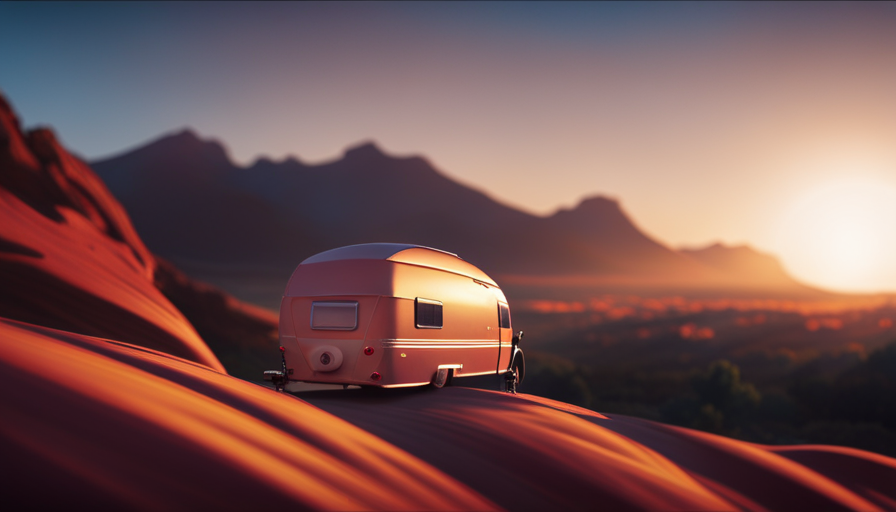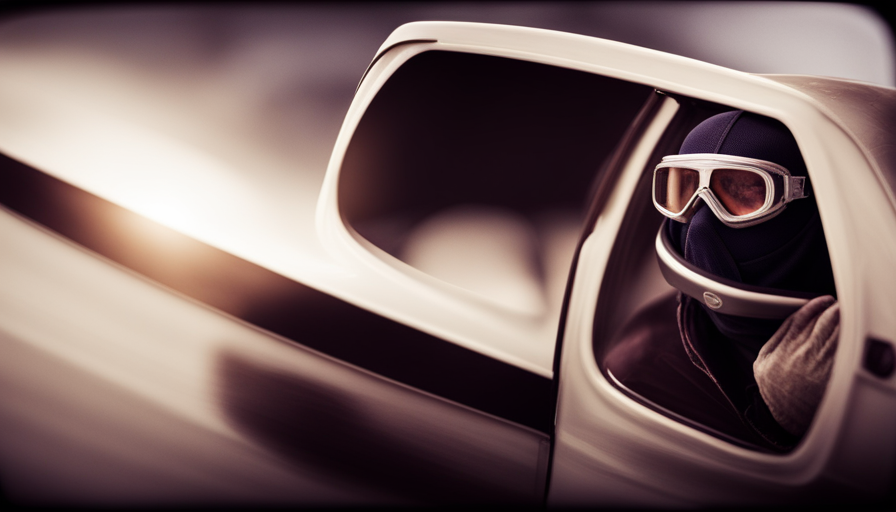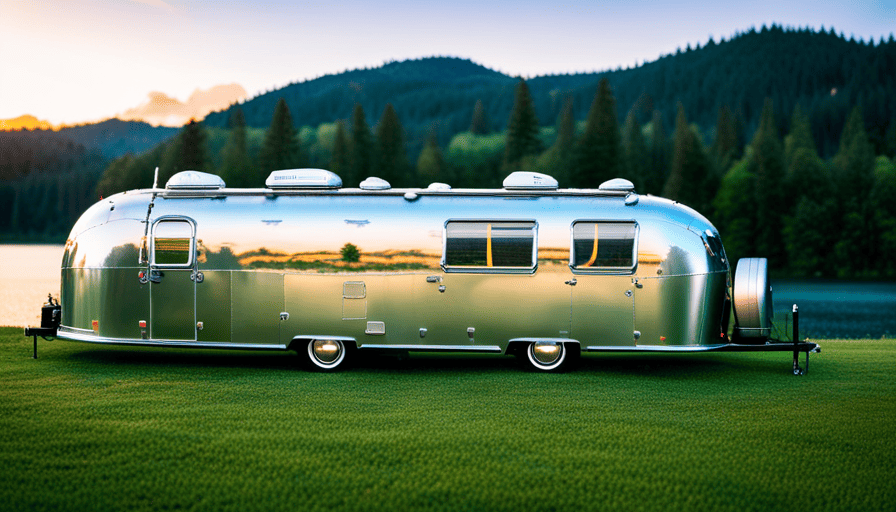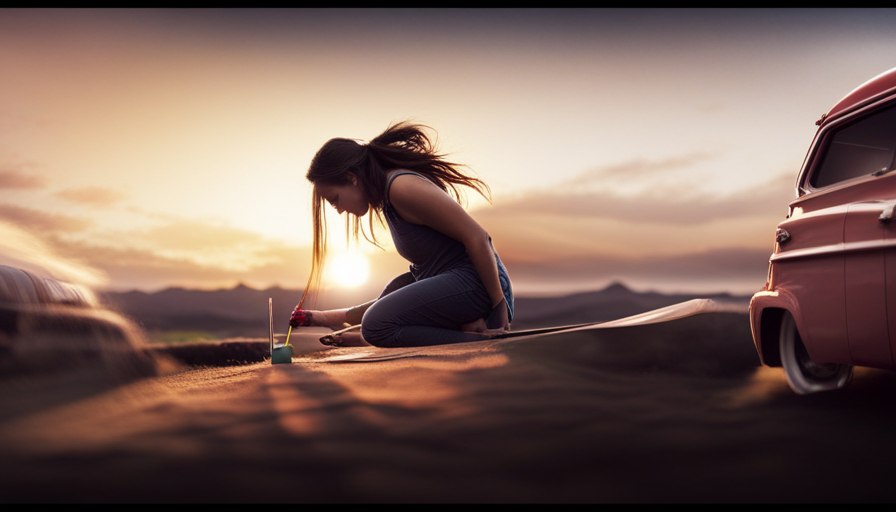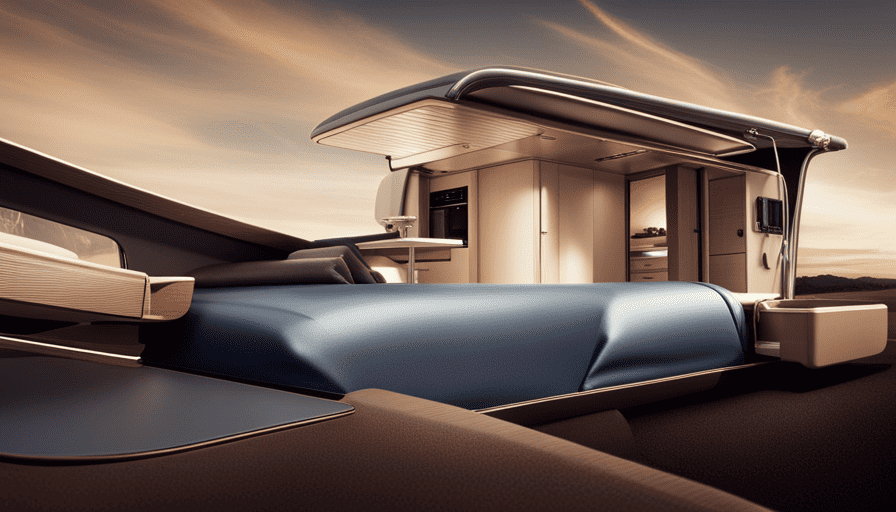Have you ever fantasized about going on a cross-country journey in a camper that reflects your individuality? I’m here to let you know that with some knowledge and effort, you can turn the outside of your camper into a masterpiece on wheels.
In this article, I will guide you through the step-by-step process of painting a camper exterior, sharing my firsthand knowledge and expertise to help you achieve the stunning results you desire.
Before you dive into the world of camper painting, it’s important to assess the condition of your vehicle and choose the right paint and supplies for the job. Once you’ve gathered all the necessary materials, we’ll move on to removing and protecting any exterior accessories, prepping the surface, and applying a primer.
Then, it’s time to let your creativity shine as we add those special touches that will make your camper truly one-of-a-kind. Finally, we’ll finish off with a protective top coat and reattach those accessories, leaving you with a beautifully revamped camper ready for your next adventure.
So, let’s get started and turn your camper into a mobile masterpiece!
Key Takeaways
- Assess the condition of the camper before painting and make any necessary repairs
- Choose the right paint and supplies for the job, considering the type of paint suitable for the camper’s exterior material
- Use high-quality primer and paint for better adhesion and durability
- Properly prepare the surface by sanding, filling cracks or holes, and applying a suitable primer before painting
Assess the Condition of Your Camper
You need to take a close look at your camper to see if there are any areas that need repairs before you start painting it. Assessing the damage is crucial to ensure a smooth and successful painting process.
Start by inspecting the exterior for any cracks, dents, or scratches. These imperfections can be easily fixed with some basic repairs. If you notice any damaged fiberglass, it’s essential to repair it before painting. Fiberglass repair kits are readily available and can be used to fix any cracks or holes. Make sure to follow the manufacturer’s instructions for a proper repair.
Once you have assessed the condition of your camper and made any necessary repairs, it’s time to choose the right paint and supplies. This step is crucial as it will determine the longevity and appearance of the paint job. Consider the type of paint that’s suitable for the camper’s exterior material, whether it’s fiberglass, aluminum, or steel. Additionally, opt for a high-quality primer and paint that’s specifically designed for outdoor use. These products will provide better adhesion and durability.
Assessing the condition of your camper and repairing any damages are essential steps before starting the painting process. Once these tasks are completed, you can move on to choosing the right paint and supplies for a successful camper exterior makeover.
Choose the Right Paint and Supplies
Selecting the appropriate paint and necessary materials is like finding the perfect brushstroke for your mobile oasis.
When it comes to choosing the right paint color for your camper’s exterior, there are a few things to consider. First, think about the overall aesthetic you want to achieve. Do you prefer a bold and vibrant look or a more subtle and understated one? Once you have a vision in mind, head to your local paint store and browse through their selection. Don’t be afraid to ask for samples to test on a small area of your camper to see how the color looks in different lighting conditions.
Tips for painting in different weather conditions are also important to keep in mind. If you’re painting on a hot and sunny day, make sure to work in the shade to avoid the paint drying too quickly. On the other hand, if you’re painting in cooler temperatures, consider using a paint that’s specifically designed for colder weather.
Incorporate these tips into your paint selection process, and you’ll be well on your way to transforming your camper’s exterior.
Now, let’s move on to the next step of the process: removing and protecting exterior accessories.
Remove and Protect Exterior Accessories
When it’s time to transform my mobile oasis, I always take a moment to remove and safeguard the exterior accessories. This step is crucial in ensuring that the painting process goes smoothly and that all delicate areas are protected.
I start by carefully removing any detachable accessories such as awnings, vents, and light fixtures. These items can easily be damaged by overspray or accidental paint drips, so it’s essential to set them aside in a safe place.
Next, I cover any remaining accessories that can’t be removed with protective materials such as plastic sheets or masking tape. This prevents them from getting damaged or covered in paint during the painting process. I pay extra attention to delicate areas such as windows, door handles, and decals, making sure they’re well-protected.
Protecting these delicate areas and preventing overspray is crucial to achieving a professional-looking paint job. Once all the exterior accessories are removed or covered, I can move on to the next step: prepping the surface. By ensuring that everything’s properly protected, I can focus on getting the camper’s exterior ready for a fresh coat of paint.
Prep the Surface
Before painting the camper exterior, it’s crucial to properly prepare the surface. I start by sanding down any rough areas or old paint to create a smooth and even surface.
Next, I carefully inspect for any cracks or holes, and if I find any, I fill them in with putty or filler to ensure a seamless finish.
Taking the time to prep the surface thoroughly will guarantee a professional-looking paint job that lasts for years to come.
Sand down any rough areas or old paint
Smoothly sand any rough areas or remove old paint to prepare the camper for a fresh coat of color. When repairing dents, it is important to first assess the severity of the damage. For small dents, a lighter grit sandpaper, such as 120-grit, is recommended. This will allow for a smoother finish without causing further damage to the surface. For larger dents, a coarser grit, like 80-grit, may be necessary to effectively reshape the area. Always remember to sand in a circular motion, gradually blending the sanded area with the surrounding surface. Once the rough areas are sanded down, wipe away any dust and debris before moving on to the next step. Now that the surface is smooth and free of imperfections, it’s time to fill in any cracks or holes with putty or filler.
Fill in any cracks or holes with putty or filler
After sanding down any rough areas or old paint on the camper exterior, the next step is to fill in any cracks or holes with putty or filler. This is an important step to ensure a smooth and even surface for painting.
When it comes to applying putty or filler, proper techniques are essential. Start by cleaning the area thoroughly and then apply the putty or filler using a putty knife or a flexible plastic spreader. Make sure to follow the manufacturer’s instructions for drying time and sanding.
There are various options available for filling cracks and holes in a camper. Some popular choices include epoxy putty, which is durable and resistant to water, and auto body filler, which is easy to shape and sand. It’s important to choose a putty or filler that’s specifically designed for outdoor use and can withstand the elements.
With the cracks and holes filled, the next step is to prime the camper, creating a solid foundation for the paint to adhere to.
Prime the Camper
First, you’ll need to grab your primer and get ready to transform your camper into a stunning work of art. Choosing the right primer is essential to ensure a long-lasting and professional-looking paint job. Look for a primer specifically designed for exterior surfaces, as it’ll provide the best adhesion and durability. Additionally, consider the type of paint you’ll be using and choose a primer that’s compatible with it.
Before applying the primer, make sure the surface is clean and free of any dirt, grease, or loose paint. Use a mild detergent and water to wash the camper thoroughly, and then allow it to dry completely.
Once the surface is clean and dry, you can start applying the primer.
Tips for a smooth primer application include using a high-quality brush or roller to ensure even coverage. Work in small sections, applying the primer with long, smooth strokes. Avoid applying too much pressure, as it can lead to streaks or unevenness. Allow the primer to dry completely before moving on to the next step.
Now that the camper is primed and ready, it’s time to start painting.
Start Painting
Get ready to unleash your creativity and bring your camper to life with a fresh burst of color. The next step in painting your camper exterior is to start painting. Before you begin, make sure you’ve chosen the perfect paint color for your camper. Consider the overall look you want to achieve and select a color that complements your style.
Once you have your paint color, it’s time to get started. To achieve a smooth finish, it’s important to use the right techniques. Start by applying a thin and even coat of paint using a high-quality paintbrush or roller. Work in small sections to ensure that the paint is applied evenly and doesn’t dry before you can blend the edges. If you notice any drips or uneven areas, gently sand them down and apply another coat of paint. Repeat this process until you achieve the desired coverage and smoothness.
Now that you’ve learned the techniques for achieving a smooth finish, it’s time to move on to adding creative touches to your camper.
Add Creative Touches
Now it’s time to let your imagination run wild and add those special artistic details to make your camper truly unique. When it comes to adding creative touches to your camper’s exterior, unique color choices are a great way to make a statement. Consider bold and vibrant colors that reflect your personality and style. Whether you opt for a sleek metallic finish or a playful combination of hues, the choice is yours.
In addition to unique color choices, adding decals or stencils can take your camper’s exterior to the next level. You can find a wide range of pre-made decals and stencils that cater to different themes and designs. From nature-inspired motifs to geometric patterns, there’s something for everyone. If you’re feeling extra creative, you can even design your own decals or stencils to truly personalize your camper.
Once you’ve added these creative touches, allow the paint to dry completely. This is an important step to ensure that your hard work lasts for years to come.
Allow the Paint to Dry
Once your masterpiece is complete, sit back and watch as the vibrant colors come to life, drying to a flawless finish that will withstand the test of time.
The drying time for camper paint can vary depending on several factors, such as the type of paint used and the weather conditions. It’s crucial to allow the paint to dry completely before moving on to the next step to avoid any potential paint smudges or damage.
To ensure proper drying, it’s recommended to wait at least 24 to 48 hours before handling or applying any additional coats of paint. Keep in mind that if the weather is humid or cold, it may take longer for the paint to dry completely. Patience is key in this process, as rushing it may result in a less durable and professional-looking finish.
To avoid any accidental contact with wet paint, it’s essential to create a designated area where the camper can dry undisturbed. This will help prevent any smudges or unwanted marks on the freshly painted surface. Additionally, it’s crucial to keep pets and children away from the drying area to ensure a flawless result.
Once the paint has dried completely, you can proceed to the next step: applying a protective top coat. This will provide an extra layer of protection to your camper’s exterior, safeguarding it against harsh weather conditions and ensuring its longevity.
Apply a Protective Top Coat
To achieve a long-lasting and weather-resistant finish, it’s time to give your masterpiece an added layer of protection by applying a protective top coat.
When it comes to selecting a protective top coat for your camper’s exterior, there are a few options to consider. One popular choice is a clear coat, which provides a transparent barrier that not only protects the paint but also enhances its shine. Another option is a UV-resistant top coat, which shields your camper from the damaging effects of the sun’s rays. This is especially important if your camper spends a lot of time exposed to direct sunlight.
Additionally, there are top coats available that offer added protection against scratches and abrasions, ensuring that your camper stays looking its best for years to come.
Using a protective top coat offers several benefits. First and foremost, it prolongs the lifespan of the paint on your camper’s exterior. By creating a protective barrier, it helps to prevent fading, chipping, and peeling. Secondly, it adds an extra layer of defense against the elements, including rain, snow, and UV rays. This is particularly important if you plan on taking your camper on outdoor adventures where it will be subjected to harsh weather conditions. Lastly, a protective top coat makes your camper easier to clean and maintain. It repels dirt, grime, and other contaminants, making it a breeze to keep your camper looking fresh and vibrant.
Now that you’ve applied a protective top coat to your camper’s exterior, it’s time to reattach any accessories that were removed during the painting process. With your newly protected and refreshed camper, it’s time to hit the road and enjoy your new look.
Reattach Accessories and Enjoy Your New Look
With your accessories securely back in place, it’s time to hit the road and bask in the glory of your camper’s refreshed and stylish new appearance. But before you do, let’s discuss a couple of ideas related to the current subtopic.
First, choosing the right color scheme can make a world of difference in transforming the look of your camper. Consider colors that complement each other and reflect your personal style. Whether you prefer vibrant and bold shades or a more subtle and calming palette, the choice is yours.
Once you’ve applied a protective top coat to your camper’s exterior, it’s important to properly clean and maintain it to ensure its longevity. Regularly wash your camper using a mild soap and water solution, avoiding any abrasive materials that could scratch the paint. Additionally, be sure to address any dirt or stains promptly to prevent them from becoming more difficult to remove. Lastly, consider applying a wax or sealant to provide an extra layer of protection against the elements.
By following these suggestions and taking care of your newly painted exterior, you can enjoy your camper’s new look for years to come. So go ahead, hit the open road, and embark on new adventures with confidence and style. Safe travels!
Frequently Asked Questions
How long does it typically take for the paint to dry on a camper exterior?
Oh, the joy of waiting for paint to dry on a camper exterior! The drying time can vary depending on the weather conditions, but typically it takes around 24-48 hours for the paint to fully dry. However, keep in mind that factors like humidity and temperature can affect the drying process.
So, make sure to choose a sunny and dry day to paint your camper, and be patient as you eagerly wait for that flawless finish to come to life.
Can I paint my camper with regular house paint?
Yes, you can paint your camper with regular house paint, but there are some pros and cons to consider. The main advantage is that regular house paint is readily available and often less expensive than specialized camper paint. However, regular house paint may not be as durable or long-lasting as paint specifically designed for campers. It may also not adhere as well to the camper’s exterior, leading to peeling or chipping over time.
What type of protective top coat should I use on my camper after painting?
When it comes to protecting your freshly painted camper, choosing the right top coat is crucial. Did you know that using a high-quality top coat can increase the lifespan of your paint job by up to 50%?
There are several protective top coat options available, such as automotive clear coats or marine-grade sealants. To ensure the best results, it’s important to follow some best practices for applying the top coat, including proper surface preparation, even application, and allowing sufficient drying time.
Should I remove all exterior accessories before painting my camper?
Can I paint my camper without removing exterior accessories?
While it’s possible to paint your camper without removing all exterior accessories, it’s generally recommended to do so. Removing accessories such as handles, lights, and trim will allow for a smoother and more even paint job. Additionally, it’ll ensure that the paint reaches all areas, preventing any missed spots. Not removing these accessories can result in a less professional-looking finish.
Can I paint my camper in cold or humid weather?
Painting a camper in cold or humid weather is not ideal. These conditions can affect the drying process and result in a poor paint job. It’s best to wait for a dry and warm day to ensure the paint adheres properly and dries evenly.
When it comes to painting techniques, make sure to prepare the surface by cleaning and sanding it. Use primer before applying the paint for better adhesion and longevity.
Is It Necessary to Seal the Roof Before Painting the Exterior of a Camper?
Before painting the exterior of a camper, it is essential to consider sealing camper roof options. By properly sealing the roof, you can prevent any potential leaks or water damage that could occur in the future. This ensures a long-lasting paint job and helps protect your camper from adverse weather conditions. Take the necessary steps to seal the roof before starting the painting process for optimum results.
Conclusion
Well, painting my camper was quite the adventure! I assessed the sad condition of my trusty old camper and decided it needed a fresh coat of paint to bring it back to life. After choosing the perfect paint and gathering all the necessary supplies, I went to work.
Removing and protecting the exterior accessories was a bit tricky, but I managed to do it without a hitch. Prepping the surface was a tedious task, but it was totally worth it in the end. I applied a primer to ensure a smooth and long-lasting finish, and then the fun part began – adding creative touches!
I let my imagination run wild and transformed my camper into a work of art. After patiently waiting for the paint to dry, I applied a protective top coat to keep my masterpiece looking fabulous for years to come. Finally, I reattached all the accessories, and voila! My camper now looks brand new, and I couldn’t be happier with the results.
Painting a camper may seem daunting, but with a little know-how and a lot of patience, anyone can do it. So go ahead, grab a brush, and let your creativity soar!

